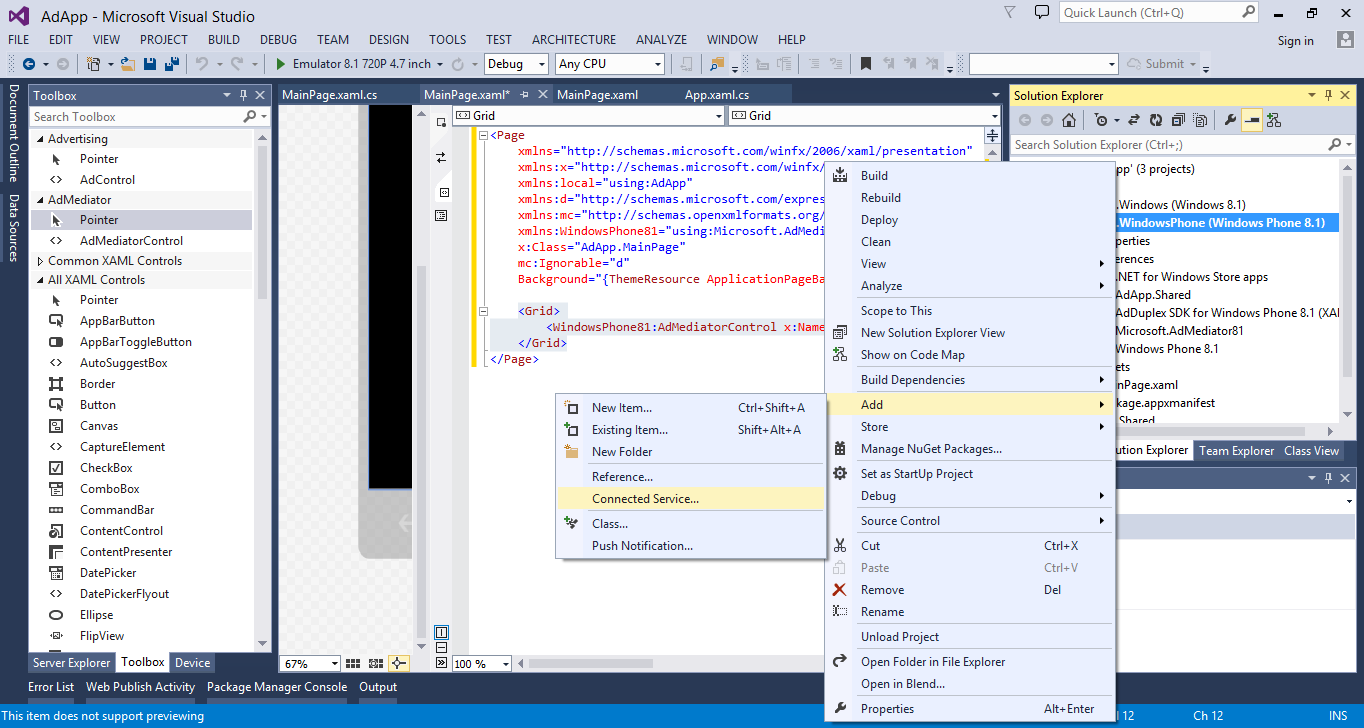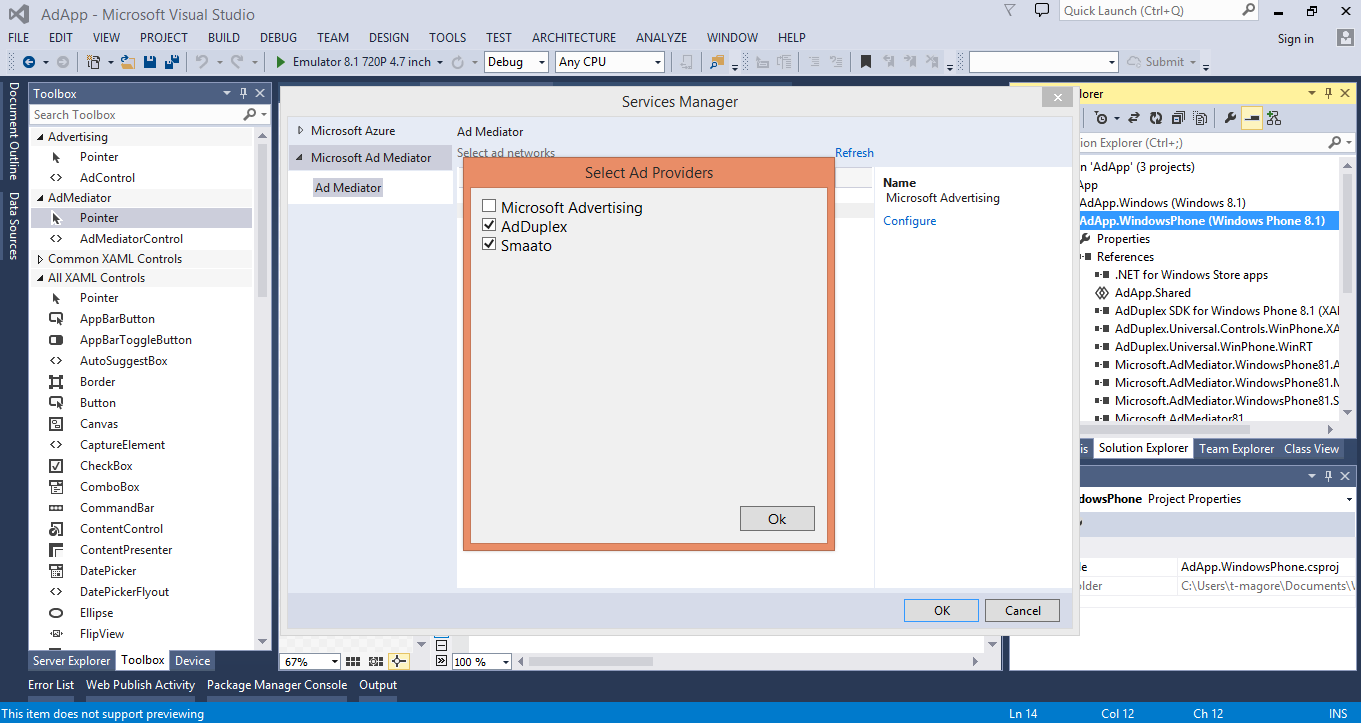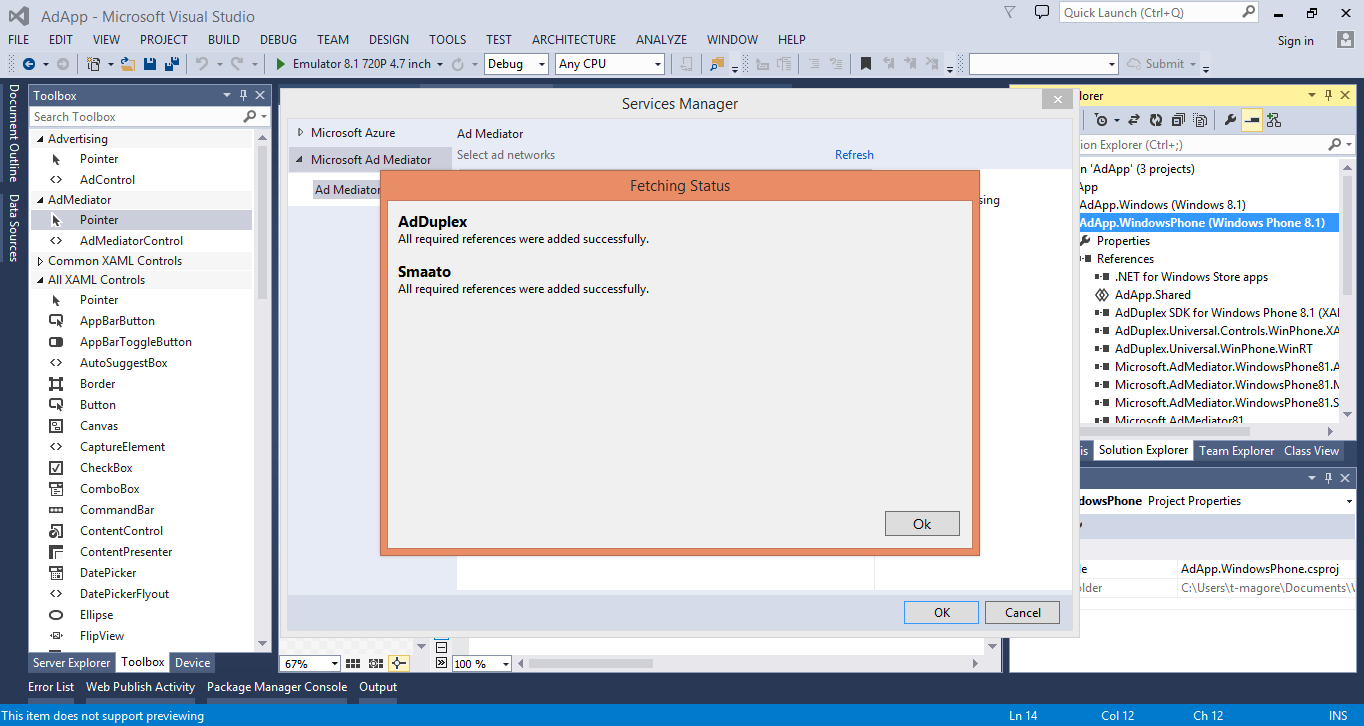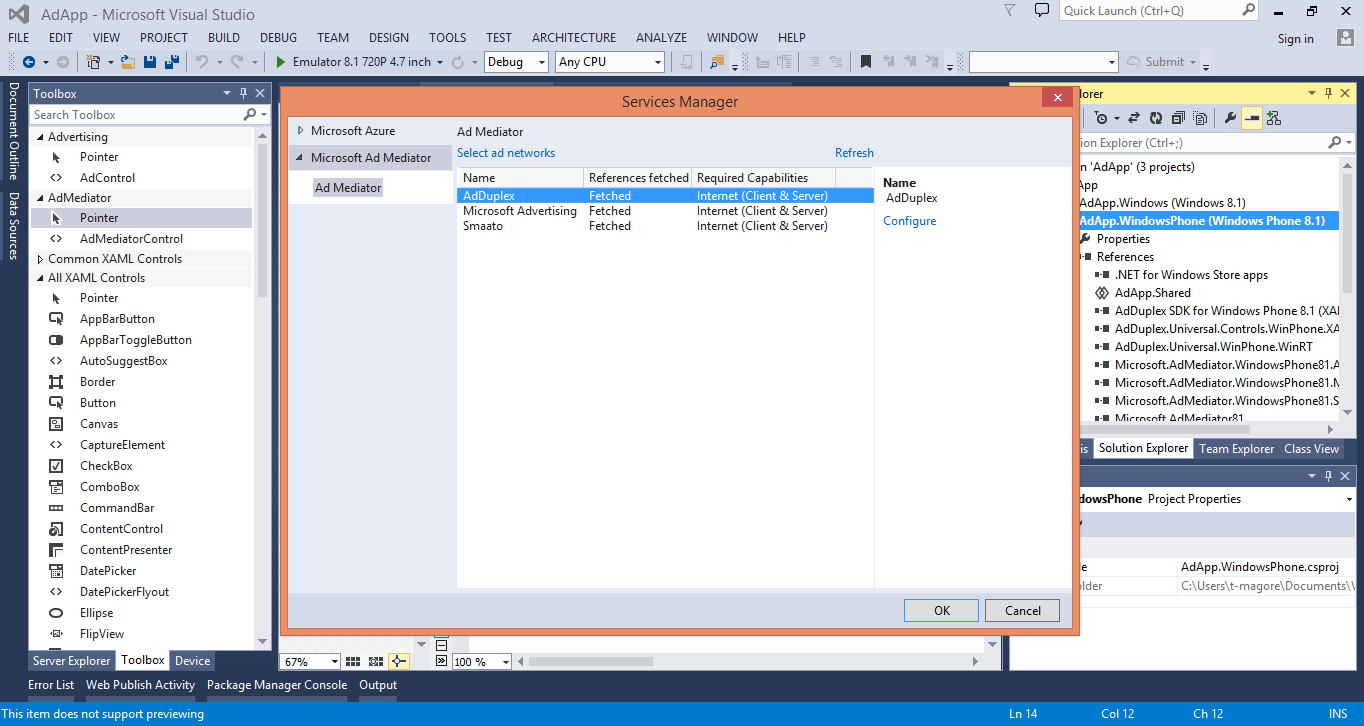Windows Ad Mediator - an advanced way to monetize applications on Windows Phone
A new era of monetization of applications on Windows Phone has come with the release of the Ad Mediator extension, which features the aggregation and management of several SDK ad networks.
Ad Mediator allows you to broadcast information from various ad networks in your application and implements a sequential call algorithm for different SDKs . If the application does not receive content when it calls the ad network element, it starts contacting other SDK, connected ad networks.

Compared to using one ad network, the Ad Mediator mechanism provides access to managing and integrating several ad networks into the SDK application, as well as the ability to optimize their use.
')
Developers can customize the frequency of use of selected ad networks, as well as the display options for networks by region.
Reports and configuration of ad mediation (advertising intermediary) for ad networks, determining the way advertising requests are distributed are available in the Windows Phone Developer Center :

Ad Mediator is available for Windows Phone 8.1 applications on XAML and Windows Phone 8 / Windows Phone 8.1 applications on Silverlight. The extension is evolving towards supporting Windows Phone 8.1 applications using JavaScript and Windows Store applications.
Ad Mediator currently supports the AdDuplex , Smaato, and Micsoroft ad networks SDK. In addition to the listed networks, Windows Phone applications on Silverlight also support AdMob , MobFox , InMobi, and Inneractive .
In order to use the Ad Mediator extension, you must install it using the Visual Studio extension gallery .
Then register on the portals of supported ad networks, for example, as described in the next article.
If, before installing AdMediator, your application has already used an ad network SDK, for example, AdDuplex, then before using the extension component in the application, remove all links to the previously connected advertising SDK.
After installing the extension and restarting Visual Studio, add the AdMediatorControl element to the application:

We get the following new lines in the XAML code of the application:
The value of the parameter Name, can be changed to any that corresponds to the purpose of the element, the parameter ID is not recommended to be changed.
Now configure the item using Connected Services:

Click on the “Select ad networks” button and select ad networks for the application:


And all the necessary dll advertising networks successfully added to the project:

You can also change the set of connected ad networks after publishing the application in the Windows Phone Developer Center.
Click on "Configure" to fill in the data obtained during registration on the portals of advertising networks, and run the application.
The default banner size is 480x80 for Windows Phone8 / 8.1 applications on Silverlight, and 400x66 for Windows Phone 8.1 XAML applications. It should be provided that the banner size is sufficient to display the content of the selected ad networks. Some networks may not provide content if the border of the banner is too small to display the ad unit completely.
If any of the blocks is larger than the default size, then it is possible to customize the size of the banner using additional parameters:
Details about AdMediator on MSDN .
Ad Mediator is not just an extension for displaying banners of several ad networks in an application on Windows Phone, but part of a whole new ad mediation algorithm available to mobile application developers.
The integration of this component in the application allows you to create and use various options for the broadcast of advertising, in accordance with the popularity of the advertising network in a particular region. And also receive a detailed report on the effectiveness of the current advertising configuration in the Windows Phone Developer Center.
The following article provides information on the increase in advertising revenue in a Windows Phone application using the ad mediation algorithm, compared with the integration of the SDK of only one advertising network.
Ad Mediator allows you to broadcast information from various ad networks in your application and implements a sequential call algorithm for different SDKs . If the application does not receive content when it calls the ad network element, it starts contacting other SDK, connected ad networks.

Compared to using one ad network, the Ad Mediator mechanism provides access to managing and integrating several ad networks into the SDK application, as well as the ability to optimize their use.
')
Developers can customize the frequency of use of selected ad networks, as well as the display options for networks by region.
Reports and configuration of ad mediation (advertising intermediary) for ad networks, determining the way advertising requests are distributed are available in the Windows Phone Developer Center :

Support
Ad Mediator is available for Windows Phone 8.1 applications on XAML and Windows Phone 8 / Windows Phone 8.1 applications on Silverlight. The extension is evolving towards supporting Windows Phone 8.1 applications using JavaScript and Windows Store applications.
Ad Mediator currently supports the AdDuplex , Smaato, and Micsoroft ad networks SDK. In addition to the listed networks, Windows Phone applications on Silverlight also support AdMob , MobFox , InMobi, and Inneractive .
Using Ad Mediator in the app
In order to use the Ad Mediator extension, you must install it using the Visual Studio extension gallery .
Then register on the portals of supported ad networks, for example, as described in the next article.
If, before installing AdMediator, your application has already used an ad network SDK, for example, AdDuplex, then before using the extension component in the application, remove all links to the previously connected advertising SDK.
After installing the extension and restarting Visual Studio, add the AdMediatorControl element to the application:

We get the following new lines in the XAML code of the application:
xmlns:WindowsPhone81="using:Microsoft.AdMediator.WindowsPhone81" <Grid> <WindowsPhone81:AdMediatorControl x:Name="AdMediator_AAB340" HorizontalAlignment="Left" Height="67" Id="AdMediator-Id-11EE90CB-F300-4A37-B7ED-52391BB5EAD4" Margin="73,362,0,0" VerticalAlignment="Top" Width="400"/> </Grid> The value of the parameter Name, can be changed to any that corresponds to the purpose of the element, the parameter ID is not recommended to be changed.
Now configure the item using Connected Services:

Click on the “Select ad networks” button and select ad networks for the application:


And all the necessary dll advertising networks successfully added to the project:

You can also change the set of connected ad networks after publishing the application in the Windows Phone Developer Center.
Click on "Configure" to fill in the data obtained during registration on the portals of advertising networks, and run the application.
The default banner size is 480x80 for Windows Phone8 / 8.1 applications on Silverlight, and 400x66 for Windows Phone 8.1 XAML applications. It should be provided that the banner size is sufficient to display the content of the selected ad networks. Some networks may not provide content if the border of the banner is too small to display the ad unit completely.
If any of the blocks is larger than the default size, then it is possible to customize the size of the banner using additional parameters:
AdMediator.AdSdkParameters[AdSdkNames.AdDuplex]["Width"] = 400; AdMediator.AdSdkParameters[AdSdkNames.AdDuplex]["Height"] = 80; Details about AdMediator on MSDN .
Conclusion
Ad Mediator is not just an extension for displaying banners of several ad networks in an application on Windows Phone, but part of a whole new ad mediation algorithm available to mobile application developers.
The integration of this component in the application allows you to create and use various options for the broadcast of advertising, in accordance with the popularity of the advertising network in a particular region. And also receive a detailed report on the effectiveness of the current advertising configuration in the Windows Phone Developer Center.
The following article provides information on the increase in advertising revenue in a Windows Phone application using the ad mediation algorithm, compared with the integration of the SDK of only one advertising network.
useful links
- Try Azure for free for 30 days!
- Microsoft Azure Development Center (azurehub.ru) - scripts, tutorials, examples, design recommendations
- Twitter.com/windowsazure_ru - the latest Microsoft Azure news
- Microsoft Azure Community on Facebook - experts, questions
- Explore Microsoft Virtual Academy courses on cloud and other technologies
- Business and the cloud: best practices solutions
- Windows 8.1 Update for large organizations. Beginning of work
- Microsoft Hybrid Cloud: Typical Solutions Guide
- Toolkit for preparing users for Windows 8.1
- Introduction to the Win2D Graphic Library
- Download free or trial Visual Studio
- Become a universal Windows application developer
Source: https://habr.com/ru/post/245573/
All Articles